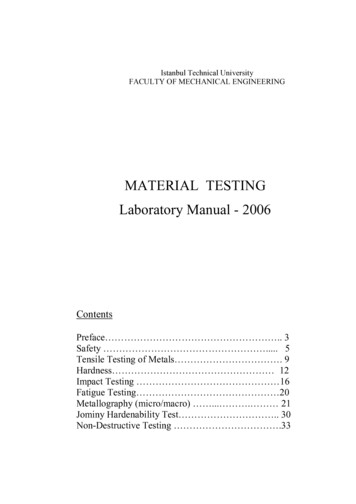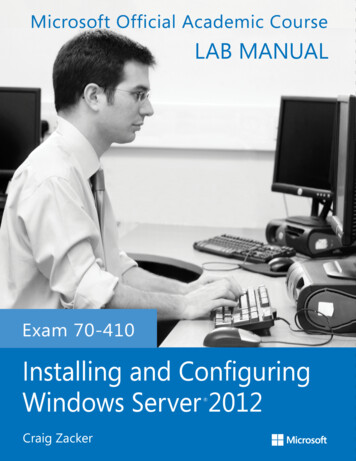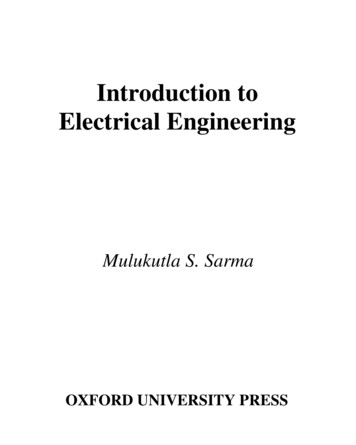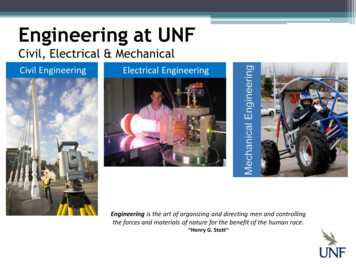
Transcription
ATRIA INSTITUTE OF TECHNOLOGY(Affiliated To Visvesvaraya Technological University, Belgaum)Anandanagar, Bangalore-24DEPARTMENT OF ELECTRONICS AND COMMUNICATIONBASIC ELECTRICAL ENGINEERINGLAB MANUALFIRST / SECOND SEMESTER ( COMMON TO ALL BRANCHES )SUBJECT CODE: 18ELEL 17/272020-21
ATRIA INSTITUTE OF TECHNOLOGY(Affiliated To Visvesvaraya Technological University, Belgaum)Anandanagar, Bangalore-24DEPARTMENT OF ELECTRONICS AND COMMUNICATIONBASIC ELECTRICAL ENGINEERING LAB MANUALThe Basic Electrical Laboratory Manual pertaining to I /II semester commonto all Branches has been prepared as per VTU syllabus and all the experiments aredesigned, tested and verified according to the experiment list.This manual typically contains practical/lab sessions related to DC circuits,AC circuits and Electrical machines covering various aspects related to the subjectfor better understanding. Students are advised to go through the manual thoroughlyas it provides them practical insights.Good Luck for your Enjoyable Laboratory Sessions
Sl.No.Content1Course Objectives & Outcomes2Syllabus3List of ExperimentsConduction Experiments4Expt-1 : Verification of KCL and KVL for DC circuits5Expt-2 : Measurement of current, power and power factor of incandescent lamp,678910111213fluorescent lamp, and LED lamp.Expt-3: Measurement of resistance and inductance of a choke coil using 3voltmeter methodExpt-4: Determination of phase and line quantities in three phase star and deltaconnected loadsExpt-5: Measurement of three phase power using two wattmeter method.Expt-6: Two way and three way control of lamp and formation of truth tableExpt-7: Study of effect of open and short circuit in simple circuitsExpt-8: Measurement of Earth ResistanceDemo ExperimentsDemo Expt-1 : Demonstration of fuse and MCB separately by creating a fault.Demo Expt-2 : Demonstration of cut-out sections of electrical machines 23-2425-2728-36machines, Induction machines and synchronous machines).1437-4215Demo Expt-3 : Understanding ac and dc supply. Use of tester and test lampto ascertain the healthy status of mainsDemo Expt-4 : Understanding of UPS16Viva questions45-4616Department Vision & Mission4643-44
Basic Electrical Lab ManualAtria IT,BangalorePage 1
Basic Electrical Lab ManualAtria IT,BangalorePage 2
Basic Electrical Lab ManualExperiment No-1VERIFICATION OF KVL AND KCL FOR DC CIRCUITSAIM: To verify Kirchhoff’s Voltage Law (KVL) and Kirchhoff’scurrent Law (KCL)APPARATUS REQUIRED:1. KCL/KVL Kit2. Ammeter3. Voltmeter4. Connecting wiresTHEORY:Kirchoffs Voltage law states that the algebraic sum of the products of current andresistance in each of the conductor in any closed mesh (or) path in a network plus thealgebraic sum of the voltages in that path is zero IR V 0Kirchoffs current law states that the algebraic sum of the currents meeting at a point (or)junction is zero.or in any electrical network sum of the currents leaving from a point(node)is equal to the sum of currents entering the node.CIRCUIT DIAGRAM OF KVLAtria IT,BangalorePage 3
Basic Electrical Lab ManualPROCEDURE (KVL) : Connect two different resistors and a supply and a current meter as shown in fig. Note that current flowing in the circuit. Find the values of IR1, IR2(or) measure the voltage drop across resistors and notethem as V1 and V2. Note:Verify IR1 IR2 V (or) V V1 V2TABULAR COLUMN OF KVLSl.NoV (volts)V1(volts) V2(volts)V V1 V2(volts)CIRCUIT DIAGRAM OF KCL :PROCEDURE (KCL): Connect circuit as shown in the diagram. Apply voltages V1 and V2. Observe that currents I1 and I2 are entering the point A whereas the current I3 isleaving the point A. Note the currents I1, I2 and I3 flowing in the circuit through the current meters. NowverifyAtria leavingPage 4
Basic Electrical Lab ManualTABULAR COLUMN OF KCL:SL.NOI1(amps)I2(amps)I3(amps)I3 I1 I2(amps)RESULT:Hence KVL and KCL is verifiedAtria IT,BangalorePage 5
Basic Electrical Lab ManualExperiment No-2MEASUREMENT OF CURRENT, POWER AND POWERFACTOR OF INCANDESCENT LAMP, FLUORESCENTLAMP AND LED LAMPAIM:Measuring the parameters of current, power and power factor ofdifferent types of bulbs like incandescent lamp, fluorescent lamp, and LED lamp usingthe kit.APPARATUS REQUIRED:a). Parameters of lamps kitb). AC Voltmeter, 300 V (Built in)c). AC Ammeter, 2 A (Built in)d). 1-ph. Wattmeter, 300 V, 1/ 2A.THEORY:To measure the parameter of current, power and power factor of the 3 types of bulbs likeLED, CFL and Incandescent lamps can be observed by using the Physitech make Parameterof Lamps Kit. Place all the 3 lamps in the respective bulb holders provided on the kit.Connect the banana terminals of transformer output to the respective bulb holder terminals,which need to be tested with the help of patch chords. Connect the wattmeter current coil inseries with output (lamp load) and connect the volt coil of the wattmeter across the output ofthe output terminals of the lamp which is in circuit.Switch on the power by placing power chord in the 3 pin socket. Maintain 230 V AC in theinput side and measure current in the ammeter. Note down the wattage reading in thewattmeter. The wattmeter reading is the power consumed by the corresponding lamp. Themultiplication of input voltage 230 V and current shown in ammeter gives the power.For incandescent lamp the cosine angle between voltage and current is Zero. Hence powerfactor is unity. The multiplication of voltage and current will give direct power consumed bythe lamp.The LED bulb and CFL bulbs are little inductive in nature, and hence power and power factorare to be measured by using the formula,P V I Cos Ø.Hence, Cos Ø P/VIAtria IT,BangalorePage 6
Basic Electrical Lab ManualWhere,P is Power consumed by the lamp in watts (wattmeter reading),I is the current drawn by the lamp in amps (ammeter reading),V is the voltage applied to the lamp in volts (voltmeter reading).The power factor i.e. cosine angle Cos Ø can be achieved by calculating from theabove formula.CIRCUIT DIAGRAM:Atria IT,BangalorePage 7
Basic Electrical Lab ManualPROCEDURE: Connect voltmeter across transformer secondary Connect ammeter in series with transformer secondary to lamp terminal (which isto be tested) Plug in the 3 pin power chord in to mains Connect the lamp which is to be tested across the secondary terminal Switch the corresponding lamp on / off switch Connect the wattmeter in series with the lamp circuit Switch on the rockery switch Note the readings of voltage, current and wattage Calculate the power factorRepeat the same for all 3 lamps to be tested.TABULATOR D lampV (volts) I (Amps) P (watts)Cos Ø P / VIRESULT:Measurement of the parameters of current, power and power factor of different types ofbulbs like incandescent lamp, fluorescent lamp, and LED lamp using the kit is observedand achieved.Atria IT,BangalorePage 8
Basic Electrical Lab ManualExperiment No-3MEASURMENT OF PARAMETERS OF CHOKE COILUSING: 3-VOLTMETER METHODAIM: -To Measure the parameters of a choke coil! Using 3-voltmeter methodAPPARATUS REQUIRED:S. No.APPARATUSRANGEQTYREMARKSContinuously1-ph Variac, 2 A1230v/0- 270v1.TYPEVariable12.50 ohms/2AWire woundRheostat3.Choke THEORY:Choke coil is highly inductive in nature, which is used in the applications wherehigh voltage surge is needed for a short duration of time. It is generally used inthe tube light circuit to give high voltage surge during starting and to maintainsteady voltage during its operation.Atria IT,BangalorePage 9
Basic Electrical Lab ManualCIRCUIT DIAGRAM;PROCEDURE: Connect the circuit as shown in figure.Switch ON the supply.Take the readings of 3-voltmeters at different supply voltages.Tabulate the readings and calculate the parameters of the choke coil.TABULATOR FORM:S.NoV, (volts)V2 (volts) V3 (volts) Cos ΦRL(ohms) XL(ohms)ZL(ohms)L (henry)CALCULATIONS:V12 V22 V32 2 V2 V3 Cos ΦCos Φ (V12 – V22 – V32) / (2 V2 V3)RL ZL Cos ΦXL ZL Sin ΦZL V3 / I ΩL XL / 2 πƒ HAtria IT,BangalorePage 10
Basic Electrical Lab ManualMODEL GRAPH:V1V3θV2PHASOR DIAGRAMRESULT:- Thus the following choke parameters are measured by 3- voltmeter Method:1) The self inductance of choke coil HenryII) The internal resistance of the choke coil ohmsIII) Power factor of the choke coil Atria IT,BangalorePage 11
Basic Electrical Lab ManualExperiment no-4VOLTAGE AND CURRENT RELATIONSHIPS OF THREEPHASE STAR/ DELTA CIRCUITSAIM:To measure 3-ph. Star and delta voltages and currents by using 3-ph transformerand resistive loads.EQUIPMENT REQUIRED: 3-Phase transformer unit .1 noAC Ammeters .3 no’s.AC Voltmeters .3no.Rheostats .3 no’s.INTRODUCTION:The 3 phase transformer unit is so designed to observe the star/star, star/delta, delta/deltaand delta/star configurations of 3-phase circuits. Any 3-phase circuits are to use one of the aboveconfigurations only. 415 V, 50 Hz, 3-phase supply is taken to the transformer as input and for theconvenience and for most safety it is step downed to 50 V AC phase to phase. This 50 V AC phase tophase supply is taken as input to our 3-phase transformer to check the Voltage and Currentrelationships of three phase star/delta circuits. The voltmeter and ammeters are given toobserve the relationship between voltage and current in star/delta circuits.The fundamental principle of star connection is that voltages will divide by Г3times andcurrent will remain same. In Delta configuration current will divide by Г3times andvoltages will remain same.CIRCUIT DIAGRAM OF STAR CONNECTIONAtria IT,BangalorePage 12
Basic Electrical Lab ManualPROCEDURE: Connect the load with help of switches and patch chords.Connect the 3-phase unitConnect the voltmeter and ammeter to measure voltage and currentConnect the circuit as shown in circuit star connectionsIn star , IL Iph and VL Г3VphTABULATOR FORM:S.NoVL (volts)IL (amps)Vph (volts)Iph (amps)VL Г3Vph(volts)CIRCUIT DIAGRAM OF STAR CONNECTIONPROCEDURE: Connect the load with help of switches and patch chords.Connect the 3-ɸ unitConnect voltmeter and ammeter to measure Voltage and current.Connect the circuits as shown in circuit delta connectionsIn delta connection,VL Vph and IL Г3IphAtria IT,BangalorePage 13
Basic Electrical Lab ManualTABULATOR FORM:S.NoVL (volts)IL (amps)Vph (volts)Iph (amps)IL Г3Iph(amps)RESULT:With the help of 3-phase transformer, the voltages and currents relationship in star /delta configurations can be observed and measuredAtria IT,BangalorePage 14
Basic Electrical Lab ManualExperiment no-5MEASUREMENT OF POWER BY TWO WATTMETERMETHODAIM:3 phase, three wire power measurement by using two wattmeter method for a balancedload in star connectionAPPARATUS REQUIRED:WATT METERS UPF 600 V, 1/ 2 AMPS- 2No’sBALANCED RESISTIVE LOAD 3 phase, 3 A -1 No’s3- PHASE VARIAC 415V/ 470 V, 4A 1 No’sDIGITAL A.C VOLTMETERS 600V – 1 noTHEORY:The method of connection of two wattmeters in two wattmeter method is: The current coils of the two wattmeters are connected in any two lines while thevoltage coil of each wattmeter is connected between its own current coil terminal andthe line without a current coil.Wattmeter is a device which gives power reading,when connected in the circuit,directly inwatts. It consists of two coils: i) Current coil ii) Pressure or Voltage coil.The symbol of wattmeter is shown in the fig. If Ic is the current through its current coil(may be phase or line depends on itsconnection) and Vpc is voltage across its pressure coil(may be phase or line dependson its connection) then Wattmeter reading isW Vpc * Ic *cos (Ic ᶺVpc) wattsAngle between Vpc and IC is to be decided from the phasor diagram.Atria IT,BangalorePage 15
Basic Electrical Lab Manual The Current coil must be connected in series with the load while voltage coil must beconnected across the system voltageCIRCUIT DIAGRAM FOR STAR CONNECTED LOADS:PROCEDURE: Connect the load with the help of switches and patch chords. Connect the 3-phase variac to the mains supply. Connect the voltmeter across 2 phases Connect the circuit as shown below either in star connection.TABULATOR FORM:SL.NoVL (volts)IL (amps)W1(watts) W2(watts P W1 W2(watts)P Г3 VL ILv Cos Φ(watts)RESULT:Hence the power measured for a balanced load connected in star is the sum ofboth watt meters.Atria IT,BangalorePage 16
Basic Electrical Lab ManualExperiment no-6TWO-WAY and THREE-WAY SWITCHAIM: To study the usage of two-way & three-way switch operation inelectrical circuit (or) wiring.APPARATUS REQUIRED: 2-way study kit-1 No3-way study kit-1 NoINTRODUCTION:Two-way control is usually used for staircase lighting as it is commonly used for stair casesand corridor lighting. It consists of two way switches. A two way switch operated always inone of the two possible positions. Three-way switch is also a type of staircase wiring. Itconsists of two way switches A and B and one intermediate switch C which can control onelamp from three different places.CIRCUIT DIAGRAM:Circuit diagram of two-way switchCircuit diagram of three-way switchAtria IT,BangalorePage 17
Basic Electrical Lab ManualTruth table of Two-way switch:S1W1W1W2W2S2W3W4W3W4LAMPONOFFOFFONTruth table of Three-way switch:Sl.No12345678Intermediate switchpositionStraight connectionCross ConnectionTWS1TWS2State of NONOFFRESULT: The truth table of one lamp is controlled from two different places in twoway switch and three different places is verified.Atria IT,BangalorePage 18
Basic Electrical Lab ManualExperiment no-7STUDY OF EFFECT OF OPEN AND SHORT CIRCUIT INSIMPLE AC CIRCUITAIM:To study the effect of an open and short circuit in a simple AC circuit using astep down isolation transformer.EQUIPMENT REQUIRED: Simple open andshort circuit study kit built-in volt and ammeters .01 1-phase, 230 V, AC, 230 V / 270 V, 2A variac . 01INTRODUCTION:In any circuit, there will be Open circuit condition, and Full or partial Loadconditions. Sometimes due to short in the load or in the path of the circuit, short circuit mayoccur. In open circuit conditions, even if the load is not connected to the circuit, still theremay be some currents will flow and which causes some losses in the circuit. This happens tomaintain the circuit in hot condition. These are called no load losses due to impedance of theelements in the circuit. In short circuit condition, there may be a short in the elements of thecircuit or may be a short in the circuit path, which causes the damage to the particularelement or to entire circuit or to mains. Hence the particular short to be removed to protectthe circuit and its elements. Due to short in the circuit, heavy currents may flow in the circuitand it causes the damage.In general, the effect in open circuit is no load energy losses, which shall beoptimum. Otherwise power losses will increase the power bill. The effect of short circuit is itwill damage the particular element or entire circuit.To study the effect in open and short circuit in a simple circuit, we havedesigned a small kit consisting of a step down transformer, since it is dangerous to short thedirect 230 v to observe short circuit effect. Hence to simulate, we have designed the circuit ona simple 24 V supply. In open circuit, the no load current, voltage and power of the circuitcan be measured by keeping the circuit in open condition.In open circuit, keep the load terminals, i.e. 24 V terminals of transformer(secondary) in open condition. Observe the no load current and voltage.In short circuit, we can t directly short the output terminals, since it is dangerousto the equipment due to heavy current passes through circuit. It may cause circuit to burn, ifproper protection is not taken. Hence by giving a small input voltage through a variac, we canobserve the short circuit condition.Atria IT,BangalorePage 19
Basic Electrical Lab ManualBy using the following formula we can calculate the no load losses and short circuit losses.P V I Cos ØWhereP is power consumed by the circuitV is the open circuit voltageI is the No load currentCos Ø is the phase angle between voltage and current.Since Resisitive load is used.Cos Ø is 1ThereforeP VI.This is the no load losses.In short circuit, across output ammeter is only connected and which will have negligibleimpedance. Hence for resistive loads phase angle is zeroThereforeP VIThis gives us the short circuit losses in the circuit.CIRCUIT DIAGRAM:OPEN CIRCUIT DIAGRAM:Atria IT,BangalorePage 20
Basic Electrical Lab ManualSHORT CIRCUIT DIAGRAM:Precaution: In any case output shall not be short circuited by keeping the variac inhigher position. It shall be kept zero and slowly to be increased till rated current isreached. Otherwise circuit will burn.PROCEDURE:To Study Open circuit: Connect the auto transformer at input terminals of the kit. (primary ofthe transformer) Keep the variac in zero position Keep the rockery switch in off condition Keep the output terminals in open condition Connect the ammeter in series and voltmeter across the primary Connect the variac power chord to mains and switch on the mains Slowly increase the output of variac till 230 v is achieved Measure the ammeter and voltmeter reading Bring back the variac to zero and switch off the mains.To Study the short circuit: Connect the auto transformer at input terminals of the kit. (primary ofthe transformer) Keep the variac in zero position Keep the rockery switch in off condition Keep the output terminals in short condition with the help of patchchord. Connect the ammeter in series across the output terminals i.e. across 24V Connect the voltmeter across the primary Connect the variac power chord to mains and switch on the mains Slowly increase the output of variac till rated current, in this case 2Amps is achieved Measure the voltmeter readingAtria IT,BangalorePage 21
Basic Electrical Lab ManualBring back the variac to zero and switch off the mainsTABULAR DIAGRAM FOR OPEN CIRCUIT :SL.NOVOLTAGE(V)CURRENT(I)POWER(W)TABULAR DIAGRAM FOR SHORT wer in open circuit Power in short circuit Atria IT,BangalorePage 22
Basic Electrical Lab ManualExperiment no-8MEASUREMENT OF EARTH RESISTANCEAIM: TO MEASURE THE EARTH RESISTIVITYAPPARATUS: EARTH TESTER-1 noSPIKES-3 noRODS, CONNECTING WIRESCIRCUIT DIAGRAM:THEORY:Measurement of Earth Resistance: The provision of an electrode for an electrical systemis necessitated by the following reasons:1.All the parts of electrical equipment like casings of machines,switches and circuitbreakers,tanks of transformers etc which have to be at earth potential must be connected to anearth electrode.the purpose of this is to protect the various parts of the installation, as well asthe persons working against damage in case the insulation of a system fails at any point.Byconnecting these parts to an earthed electrode a continuous low resistance path is availablefor leakage currents to flow to earth .the current operates the protective devices and thus thefaulty circuit is isolated in case a fault occurs.2.The earth electrode ensures that in the event of overvoltage on the system due to lightingdischarges or other system faults,those parts of equipment which are normally dead as far asvoltages are concerned do not attain dangerously high potentialsAtria IT,BangalorePage 23
Basic Electrical Lab Manual3.In a three phase circuit the neutral of the system is earthed in order to stabilize the potentialof the circuit with respect to earth.An earth electrode will only be effective so long it has a low resistance to the earthy andcan carry large currents without deteriorating. Since the amount of current which an earthelectrode will carry is difficult to measure.the resistance value of the earth electrode is takenas sufficiently reliable indication of its effectiveness.the resistance of earth electrode shouldbe low to give good protection and it must be measured.The main factors on which the resistance of any earthing system depends are:1.shape and material of earth electrode or electrodes used.2.Depth in the soil at which the electrodes are burried.3.Specific resistance of soil surrounding and in the neighbourhood of electrodes.the specificresistance of the soil is not constant but varies from one type of soil to another.the amount ofmoisture present in the soil effects its specific resistance and hence the resistance of earthelectrode is not a constant factor but suffers seasonal variations.The specific resistance of soils varies between wide limits and is very much dependent uponits moisture content.Approximate figures for specific resisttance of soil are 80 X 103Ωm formoist clay to 80 X 106Ωm for sand of normal moisture content. A decrease of moisturecontent of 30% is capable of producing an increase of 300 to 400% in specific resistance.thusit is necessary to make regular checks for earth resistance during the year round.PROCEDURE: Put the two spikes acting as current and potential electrode in to the ground at adistance of 25m and 12.5m from earth electrode under test. Connect the two spikes to E2 and P2 terminals respectively. Short the P1 and E1 terminals of motor and connect it to the earth electrode undertest. Place the megger on horizontal firm stud. Take down the 3 to 4 readings by keeping the distance same and placing theelectrodes at the other positions. Take the average of these readings which is equal to earth resistance ᶘ 2πLRTabular column:Condition of soilDRYWETSALTYL LengthR Resistanceᶘ 2πLRRESULT: The earth resistance of a soil with different conditions is measuredexperimentally.Atria IT,BangalorePage 24
Basic Electrical Lab ManualDEMO EXPERIMENTS1. DEMONSTRATION OF FUSE, MCB BY CREATING AFAULTAIM:To observe the characteristics of Fuse and MCB like short circuit and overload functions by creating a fault in the circuit.EQUIPMENT REQUIRED: Fuse and MCB demonstration kit-1no’sRheostat 3 ohms/ 8A.200V AC digital voltmeter10A AC digital ammeterSPECIFICATION: Over load protection by using fuse, 5 amps Short circuit protection of MCB Over load protection of MCB for more than 6 ampsTHEORY:1) MCB (Miniature Circuit Breaker is called as MCB is an electromechanical devicewhich protect an electric circuit from an over current. The over current, in anelectrical circuit, may result from short circuit, overload or faulty design. An MCB isa better alternative to a Fuse since it does not require replacement once an overload isdetected. Unlike fuse, an MCB can be easily operated and thus offers improvedoperational safety and greater convenience without incurring large operating cost.Miniature Circuit Breakers are used to protect lower current circuits and have thefollowing Specifications: Current rating – Amperes Short Circuit Rating - Kilo Amperes (kA) Operating Characteristics - B, C or D CurvesAtria IT,BangalorePage 25
Basic Electrical Lab ManualMiniature Circuit Breakers are usually available in the range of 0.5A to 100A.An MCB's Short circuit rating is given in Kilo amps (kA), and this indicates the level of itsability to work. For example a domestic MCB would normally have a 6kA fault level,whereas one used in an industrial application may need a unit with a 10kA faultcapability. MCB’s are protective devices that are made to break the circuit in case of overloador Short circuit. For Overload protection they have Bi-metallic strip which causes the circuitto open. For short circuit it is Electromagnetic kind of thing.WIRING DIAGRAM:2.FUSE:Fuses have a specific electric resistance value. When exposed to current, their temperaturewill rise depending on the load. Fuses with connection terminals made out of heat-resistantcopper alloy are able to withstand a temperature of up to 140 C. If we assume a temperatureof 80 C inside the engine compartment, this means the fuses can support a temperatureincrease of 60 C.Time-current Characteristics of FusesTime-current characteristics are the most important specifications of fuses.Fuses are designed to only withstand continuous current that is equivalent to their ratedcurrent. When the current flowing through a fuse exceeds the rated current, the fuse must cutoff the current within a predetermined time interval, thus ensuring the current flow isinterrupted.Atria IT,BangalorePage 26
Basic Electrical Lab ManualFor this reason, the melting time of a fuse when exposed to over current is specified byinternational and national standards for each type of fuse.Time-current standard values specify an upper threshold for the melting time to prevent anover current from flowing continuously and resulting in fire or damage to connectedelectrical wiring and electric devices. This is the ultimate purpose of a fuse. At the same time,a lower threshold is specified to ensure the current is not interrupted during the initial rush atthe start of the current flow, and thus ensure durability.Time-current characteristics differ by fuse type. For example, motor circuits employ slowblow fuses (SBF) that feature a slow-blow mechanism to withstand the comparatively longcurrent rush that is produced when a motor starts operating. It is common practice to useSBFs for circuits using motors of automatic wipers and power windows, and BFs forapplications such as lamps.The metal element inside a fuse is designed to melt through Joule heat produced byovercurrent, thus interrupting the current flow in the circuit. Because the Joule heat (I2Rt)required to melt the metal element differs based on the ambient temperature, the time atwhich the metal element in the fuse will reach its melting point will also vary. In other words,the actual capacity of a fuse will vary based on the ambient temperature.UNIT DESCRIPTION:The Fuse and MCB kit is so designed to observe the characteristics of Fuse and MCB duringover load and short circuit conditions. In general the Fuse will have over load protectiondepending upon the time duration, how much time the over load is persisting. This dependsbasically on dI/dT rating of the fuse is used. This implies that the current rated is with respectto the time constant. The rate of change of current depends on the rate of change of time.In general any MCB will be designed to protect the circuit from any short circuits and overloading. In our demonstration kit, we have used a 2 amps single pole MCB, and we canobserve the over loading effect and short circuit protection by creating a fault in the circuit.To demonstrate the MCB and Fuse characteristics, we have designed a low voltage and lowpower unit, since it is very dangerous in doing with high voltages and high power. We haveused a small isolation transformer with 2 amps current and will be safe while performing overload and short circuit tests to check the Fuse and MCB. Similarly a 5 amps Fuse is also usedin the kit to perform over load and short circuit tests in the kit.RESULT: The MCB Switch tripps off whenAtria IT,Bangaloreit exceeds the rating mentionedPage 27
Basic Electrical Lab Manual2. DEMONSTRATION OF CUT-OUT SECTION OFELECTRICAL MACHINES2a ) CUT SECTION OF DC SHUNT MOTOR:Aim:To check for working principle and viewing of cut section D.C shunt motorApparatus: D.C drive 0.5 HP, 220 V 0.5 HP D.C cut section motorSpecification: 220 VD.C shunt motor, 1500 RPM, 0.5 HP 220 V DC, 0.5 HP, 2 amps D.C driveDescription:A D.C motor is of a class of any rotary electrical machines that converts directcurrent electrical energy into mechanical energy. The most common types rely on the forcesproduced by magnetic fields. Nearly all types of D.C motors have some internal mechanism,either electromechanical or electronic; to periodically change the direction of current flow inpart of the motor.D.C motors were the first type widely used, since they could be powered fromexisting direct-current lighting power distribution systems. A D.C motor's speed can becontrolled over a wide range, using either a variable supply voltage or by changing thestrength of current in its field windings. Small D.C motors are used in tools, toys, andappliances. Larger D.C motors are used in propulsion of electric vehicles, elevator and hoists,or in drives for steel rolling mills. The advent of power electronics has made replacement ofD.C motors with A.C motors possible in many applications.A coil of wire with a current running through it generates an electromagnetic fieldaligned with the center of the coil. The direction and magnitude of the magnetic fieldproduced by the coil can be changed with the direction and magnitude of the current flowingthrough it.A simple D.C motor has a stationary set of magnets in the stator and an armature with one ormore windings of insulated wire wrapped around a soft iron core that concentrates themagnetic field. The windings usually have multiple turns around the core, and in large motorsthere can be several parallel current paths. The ends of the wire winding are connected toAtria IT,BangalorePage 28
Basic Electrical Lab Manuala commutator. The commutator allows each armature coil to be energized in turn andconnects the rotating coils with the external power supply through brushes.If external mechanical power is applied to a D.C motor it acts as a D.C generator, adynamo. This feature is used to slow down and recharge batteries on hybrid cars and electriccars or to return electricity back to the electric grid used on a street car or electric poweredtrain line when they slow down. This process is called regenerative braking on hybrid andelectric cars. In diesel electric locomotives they also use their D.C motors as generators toslow down but dissipate the energy in resistor stacks. Newer designs are adding large batterypa
12 Demo Expt-1 : Demonstration of fuse and MCB separately by creating a fault. 25-27 13 Demo Expt-2 : Demonstration of cut-out sections of electrical machines (DC machines, Induction machines and synchronous machines). 28-36 14 Demo Expt-3 : Understanding ac and dc supply. Use of tester and











